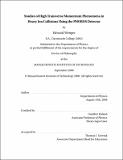| dc.contributor.advisor | Gunther Roland. | en_US |
| dc.contributor.author | Wenger, Edward (Edward Allen) | en_US |
| dc.contributor.other | Massachusetts Institute of Technology. Dept. of Physics. | en_US |
| dc.date.accessioned | 2009-04-29T14:48:55Z | |
| dc.date.available | 2009-04-29T14:48:55Z | |
| dc.date.copyright | 2008 | en_US |
| dc.date.issued | 2008 | en_US |
| dc.identifier.uri | http://hdl.handle.net/1721.1/45164 | |
| dc.description | Thesis (Ph. D.)--Massachusetts Institute of Technology, Dept. of Physics, 2008. | en_US |
| dc.description | This electronic version was submitted by the student author. The certified thesis is available in the Institute Archives and Special Collections. | en_US |
| dc.description | Includes bibliographical references (p. 137-149). | en_US |
| dc.description.abstract | The use of high-pT particles as calibrated probes has proven to be an effective tool for understanding the properties of the system produced in relativistic heavy ion collisions. In this thesis, two such measurements are presented using the PHOBOS detector at the Relativistic Heavy Ion Collider (RHIC): 1. The transverse momentum spectra of charged particles produced near mid rapidity in Cu+Cu collisions with center-of-mass energies of 62.4 and 200 GeV per nucleon pair 2. Two-particle correlations with a high transverse momentum trigger particle (pT > 2.5 GeV=c ) in Au+Au collisions at ... 200 GeV over the broad longitudinal acceptance of the PHOBOS detector ... In central Au+Au collisions at 200 GeV, the single-particle yields are suppressed at high-pT by a factor of about five compared to p+p collisions scaled by the number of binary collisions. This is typically understood to be a consequence of energy loss by high-pT partons in the dense QCD medium, as such a suppression is absent in d+Au collisions. In Cu+Cu collisions, the nuclear modification factor, RAA, has been measured relative to p+p data as a function of collision centrality. For the same number of participating nucleons (Npart), RAA is essentially the same for the Cu+Cu and Au+Au systems over the measured range of pT, in spite of the significantly different geometries. At high-pT, the similarity between the two systems can be described by simple, geometric models of parton energy loss. Two-particle angular correlations are a more powerful tool for examining how highpT jets lose energy and how the medium is modified by the deposited energy. In central Au+Au collisions, particle production correlated with a high-pT trigger is strongly modified compared to p+p. Not only is the away-side yield much broader in, the nearside peak of jet fragments now sits atop an unmistakable 'ridge' of correlated partners extending continuously and undiminished all the way to = 4. | en_US |
| dc.description.statementofresponsibility | by Edward Wenger. | en_US |
| dc.format.extent | 151 p. | en_US |
| dc.language.iso | eng | en_US |
| dc.publisher | Massachusetts Institute of Technology | en_US |
| dc.rights | M.I.T. theses are protected by
copyright. They may be viewed from this source for any purpose, but
reproduction or distribution in any format is prohibited without written
permission. See provided URL for inquiries about permission. | en_US |
| dc.rights.uri | http://dspace.mit.edu/handle/1721.1/7582 | en_US |
| dc.subject | Physics. | en_US |
| dc.title | Studies of high transverse momentum phenomena in heavy ion collisions using the PHOBOS detector | en_US |
| dc.type | Thesis | en_US |
| dc.description.degree | Ph.D. | en_US |
| dc.contributor.department | Massachusetts Institute of Technology. Department of Physics | |
| dc.identifier.oclc | 317971504 | en_US |
